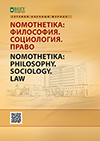Increasing female education level as a factor of fertility decline in developing countries (case studies of Latin American countries)
DOI:
https://doi.org/10.18413/2712-746X-2020-45-2-220-236Keywords:
Female Education, Fertility, Latin AmericaAbstract
Studies conducted in developed countries show a persisting differentiation of fertility and reproductive orientations depending on the level of education. We show that this differentiation persists at the stage of the completion of the demographic transition, as well. An in-depth analysis of modern fertility indicators of a number of Latin American countries based on the data of national censuses confirmed a relationship between an increase in the level of education of women and a decrease in the birth rates. The average number of children born in real cohorts of women and the general dynamics of this indicator over time vary significantly among groups of women with different levels of education. The results confirm that educational status is one of the significant factors determining the differences in fertility and reproductive behavior. An increase in the proportion of women with a relatively higher level of education contributes to lower fertility rates in Latin American countries. At the same time, the differentiating factor is probably not the very fact of achieving a particular education level, but the system of value orientations that is characteristic of people with a given level of education.
Downloads
References
Архангельский В.Н. 2006. Факторы рождаемости. М., ТЕИС, 399 с.
Вишневский А.Г. 2005. Демографическая революция. 2-е изд. М., Наука, 240 с.
Демографическая модернизация России: 1900–2000. М., Новое издательство, 2006 с.
Demograficheskaya modernizatsiya Rossii: 1900–2000. [Demographic modernization of Russia: 1900–2000]. M., Novoe izdatel'stvo, 2006 р.
Малева Т.М., Тындик А.О. 2014. Ловушка низкой рождаемости в Москве: высокообразованные бездетные? Регион: экономика и социология, 82(2): 116–136.
Тындик А.О. 2012. Образовательный фактор репродуктивного поведения населения России. Автореферат диссертации на соискание ученой степени кандидата экономических наук. Москва, 27.
Astorga P., Berges A.R., Fitzgerald V. 2005. The Standard of Living in Latin America during the Twentieth Century. The Economic History Review, 58(4): 765–796.
Benavot A., Riddle P. 1988. The expansion of primary education, 1870–1940: Trends and Issues. Sociology of Education. 61(3): 191–210.
Castro–Martin T., Juarez F. 1995. The Impact of Women's Education on Fertility In Latin America: Searching for Explanations. International Family Planning Perspectives, 21(2): 52–57.
Chesnais J.-K. 1992. The Demographic Transition: Stages, Patterns, and Economic Implications. Oxford, Clarendon Press, 174 р.
Coale A.J., Watkins S.C. 1986. The Decline of Fertility in Europe. Princeton, Princeton University Press, 522 р.
Davis K. 1945. The world demographic transition. Annals of the American Academy of Political and Social Science, 273: 1–11.
Gvirtz S., Beech J., Oria A. 2008. Schooling in Argentina. In: Going to School in Argentina. Ed. by S. Gvirtz, J. Beech. Westport, Greenwood: 5–35.
Livi-Bacci M.A. 2012. Concise History of World Population. 5th ed. London, Wiley-Blackwell, 279 р.
Mariscal E., Sokoloff K.L. 2000. Schooling, Suffrage, and the Persistence of Inequality in the Americas, 1800–1945. In: Political Institutions and Economic Growth in Latin America: Essays in Policy, History, and Political Economy. Ed. by S. Haber. Stanford, CA, Hoover Institution Press Publication: 159–217.
Newland C. 1994. The Estado Docente and Its Expansion: Spanish American Elementary Education, 1900–1950. Journal of Latin American Studies, 26(2): 449–467.
Schiefelbein E., Farrell J. P. 1980. Women, schooling, and work in Chile: Evidence from a longitudinal study. Comparative Education Review, 24(2): 160–179.
Soifer H.D. 2009. The Sources of Infrastructural Power: Evidence from Nineteenth–Century Chilean Education. Latin American Research Review, 44(2): 158–180.
Southwell M. 2013. Schooling and governance: Pedagogical knowledge and bureaucratic expertise in the genesis of the Argentine educational system. Paedagogica Historica, 49: 43–55.
Abstract views: 795
Share
Published
How to Cite
Issue
Section
Copyright (c) 2020 NOMOTHETIKA: Philosophy. Sociology. Law

This work is licensed under a Creative Commons Attribution 4.0 International License.


